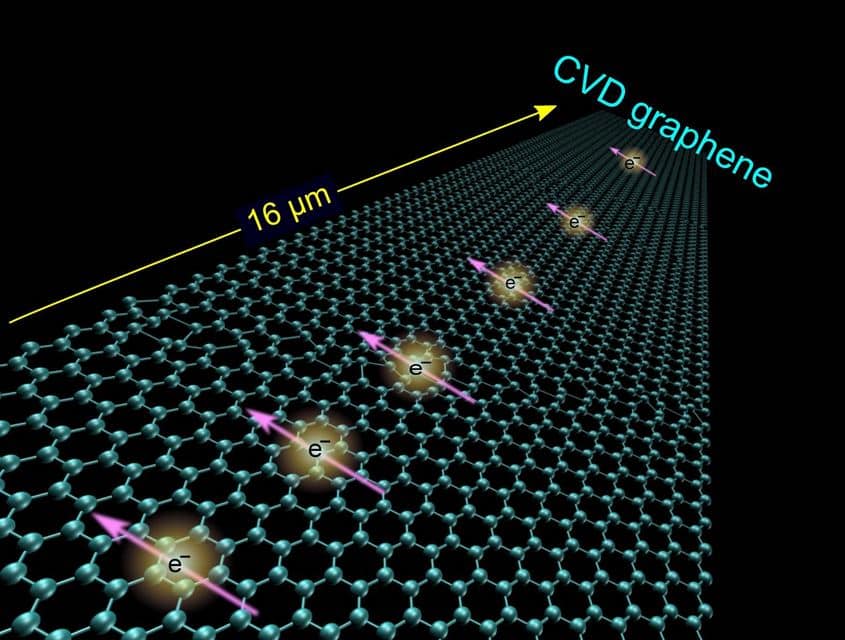Large area graphene can preserve electron spin over an extended period, and communicate it over much greater distances than scientists had previously believed possible. This has opened opportunities in developing spintronics with an aim to manufacturing faster and more energy-efficient processors and memory in computers, scientists say.
The researchers, from Chalmers University of Technology in Gothenburg, Sweden, have published their findings in the academic journal Nature Communications (citation below).
Study leader, Saroj Dash, said:
“We believe that these results will attract a lot of attention in the research community and put graphene on the map for applications in spintronic components.”

In graphene, electrons keep their magnetization, their spin (pink arrows) much longer than they do in ordinary conductors such as copper and aluminum. (Image Credit: M Venkata Kamalakar et al, Nature Communications)
Spintronics, based on the quantum state of electrons, is already being used in advanced hard drives for storing data and magnetic random access memory.
But here, the spin-based data only needs to move a few millionths of a millemetre, which is fortunate, because spin is an electron property that in most materials is extremely short-lived and fragile.
Spintronics helps processors work faster
However, there are some major benefits in exploiting spin as a data carrier, rather than, or in addition to electric charges. Spintronics could accelerate the rate at which processors work, using much less energy than they do today.
Graphene shows great promise for extending the use of spintronics in the electronics industry. Not only is the thin carbon film a super electrical conductor, but also (in theory) it has the rare ability to maintain the electrons with the spin intact.
Professor Dash said:
“In future spin-based components, it is expected that the electrons must be able to travel several tens of micrometers with their spins kept aligned.”
“Metals, such as aluminium or copper, do not have the capacity to handle this. Graphene appears to be the only possible material at the moment.”
Graphene is currently produced by a handful of companies using a number of different methods, all of them in an early phase of development. In other words, top-quality graphene is today only obtainable in tiny pieces, while larger graphene is produced in a way that the quality is either substandard or has other drawbacks, as far as the electronics industry is concerned.
CVD graphene
The findings presented by the research group at Chalmers now seriously questions that assumption. The scientists carried out their experiments using CVD graphene, which is produced through chemical deposition.
While this method gives the graphene roughness, wrinkles and some other defects, it also has advantages. There is potential to produce graphene on an industrial scale. “The CVD graphene can also be easily removed from the copper foil on which it grows and is lifted onto a silicon wafer, which is the semiconductor industry’s standard material,” the researchers explained.
While the quality of the material currently produced is far from perfect, the scientists can now show parameters of spin that are six times higher than those previously registered for CVD graphene on a similar substrate.
First author, Chalmers researchers Venkata Kamalakar, said:
“This is promising because it suggests that the spin parameters can be further improved as we develop the method of manufacturing.”
Leaving reliance on semiconductors behind
The aim is not simply to send information in a new material or replace metals or semiconductors with graphene, but to have a completely new way of performing logical operations and storing data. If this step is successful, it would take digital technology beyond its current dependence on semiconductors.
Prof. Dash said:
“Graphene is a good conductor and has no band gaps. But in spintronics there is no need for band gaps to switch between on and off, one and zero. This is controlled instead by the electron’s up or down spin orientations.”
“A short-term goal now is to construct a logical component that, not unlike a transistor, is made up of graphene and magnetic materials.”
There is still a great deal of research to be done before scientists know whether spintronics can eventually fully replace semiconductor technology. “But graphene, with its excellent spin conduction abilities, is highly likely to feature in this context,” the authors said.
Graphene, the worlds toughest, strongest, lightest, thinnest material, and also the best conductor of heat and electricity known to science, could soon revolutionize many technologies and industries.
Citation: “Long distance spin communication in chemical vapour deposited graphene,” M. Venkata Kamalakar, Christiaan Groenveld, André Dankert & Saroj P. Dash. Nature Communications. Published 10 April, 2015. DOI: 10.1038/ncomms7766.
